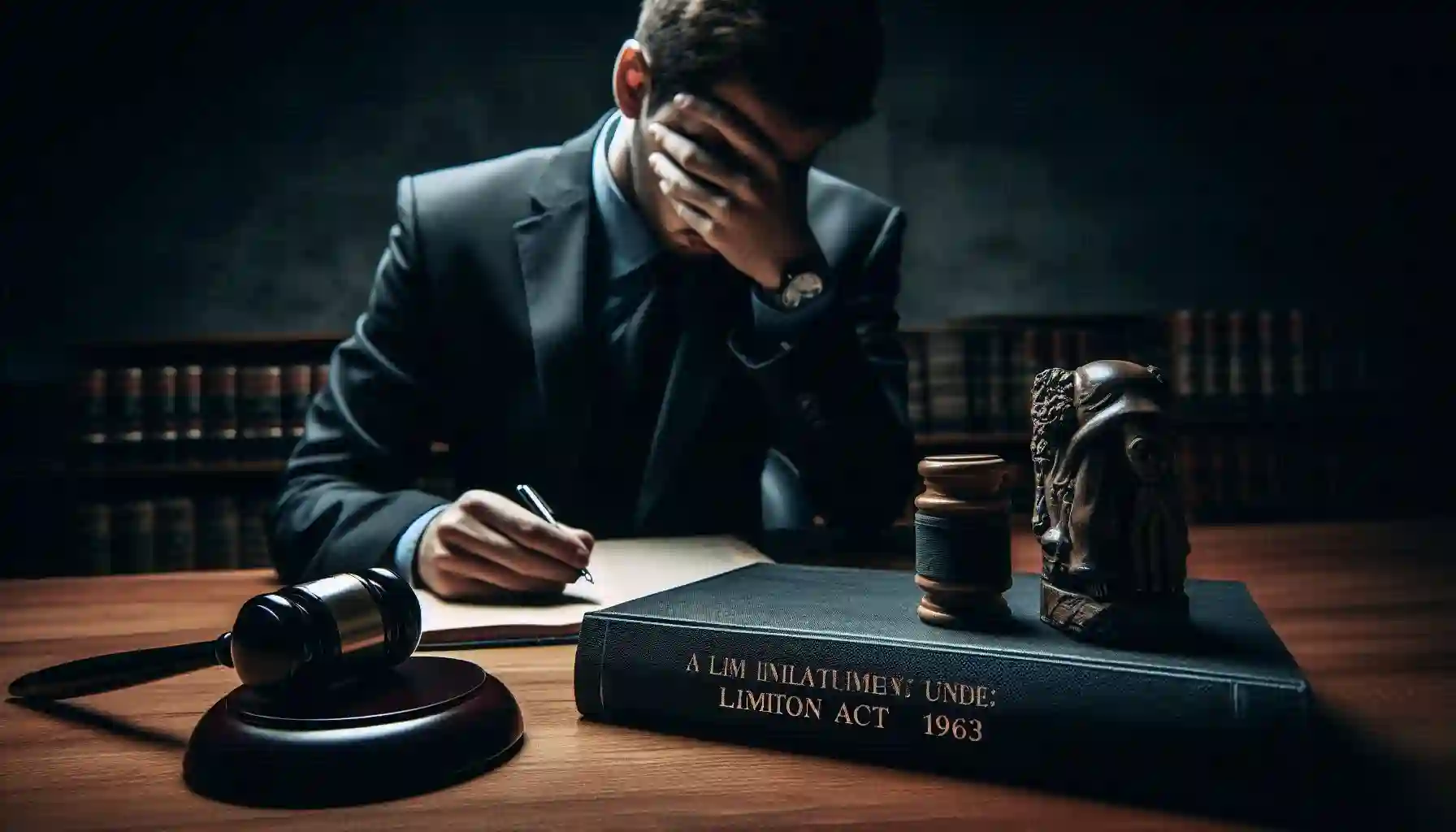Limitation Act, 1963
What is the Limitation Act, 1963?
The Limitation Act, 1963 is an important piece of legislation in India. ‘Limitation’ as a word means ‘restriction’ or ‘rule of circumstances which are limited’.
The basic concept of limitation is relating to fixing or prescribing the time period for barring legal actions. Enacted on January 1, 1964, the Limitation Act, 1963 governs the time limits for filing suits, appeals, and applications in civil cases.This act basically is a procedural law and governs the time limits within which legal proceedings can be initiated in India ensuring that they are given timely and efficiently.
In A.S. Krishnappa Chettair v. Nahiappa Chettiar (1964), it was held by the Supreme Court of India that the ‘Limitation Act’ is basically a piece of adjective or procedural law and not substantive law. The primary objective of this legislation is to prevent the filing of cases after an unreasonable lapse of time, which could lead to evidence being lost, memories fading, or witnesses becoming unavailable.
advertisement
It also protects the rights of defendants ensuring they are not disturbed after a speculated period. So basically, the major purpose of the statute of the Limitation Act, 1963 is not to destroy or infringe the rights of an aggrieved person but to serve the public in a better way and to save time. The Limitation Act contains 5 parts, 32 sections and consists of 137 articles in total.
What are the key provisions of the Limitation Act?
The Limitation Act, 1963, outlines various important provisions for filing appeals or suits before Court or Tribunals and fixing a time period for availing legal remedy for legal injuries suffered. Some key provisions are as follows:
-
Section 3: Bar of limitation This section bars legal actions filed after the expiration of the prescribed limitation period, making it the duty of the courts to dismiss such suits even if limitation is not raised by the defendant. It basically empowers the court to dismiss appeals or applications, if it is filed beyond the prescribed period of limit.
This section allows courts to accept the appeal on the next working day if the due date for filling the case expires on a non-working day or when the court is closed. In * Indian seamless steel and alloys ltd. v/s Union of India(2003) the appeal was accepted on next working day as the due date for filling the case was a holiday for the court.
- Section 5: Extension of prescribed period in certain cases This section provides for condonation of delay if the plaintiff can show a sufficient cause for not filing the appeal within the prescribed time. This is particularly relevant in appeals and applications, but not in suits.
advertisement
-
Section 12: Exclusion of time in legal proceedings This section deals with excluding certain periods, such as the day on which the limitation starts or the time taken in obtaining certified copies of judgments or orders, from the calculation of the limitation period.
-
Section 13: Exclusion of Time When Defendant is Outside India This provision provides that the period during which the defendant is out of the country is excluded from the limitation period. This provision prevents plaintiffs from being unfairly disadvantaged by the absence of the defendant.
-
Section 14: Exclusion of Time Spent in Proceedings in Good Faith This provision in limitation act allows for the exclusion of time spent in bona fide (in good faith) pursuit of a case in a court without jurisdiction (in wrong court).
-
Section 15: Exclusion of time in certain other cases This section excludes the time during which the defendant is protected from being sued due to legal impediments, such as an injunction or a stay order. If a court order prevents the filing of a suit during a particular period, that period is not counted towards the limitation.
-
Section 21: Effect of Death of Plaintiff or Defendant If a plaintiff or defendant dies during the pendency of the limitation period, the time for initiating or continuing legal proceedings is extended to allow legal representatives to act on behalf of the deceased.
advertisement
This is a significant provision in the act where the right to recover property is extinguished if no legal action is taken within the prescribed limitation period. For instance, if a person fails to file a suit for possession of immovable property within the specified time, their right to recover that property is extinguished. In Bombay Dyeing and Manufacturing Company v. the State of Bombay (1957), The Supreme Court held that the limitation bars the remedy and does not extinguish the right. Thus, the lapse of time does not extinguish the person’s right.
How are limitation periods determined under the Act?
‘Period of limitation’ is defined under section 2(j) of the act meaning the period of limitation prescribed for any suit, appeal or application by the Schedule. The determination of limitation periods under the Limitation Act, 1963, is crucial to understanding when a claimant must initiate legal proceedings to avoid dismissal.
The Act prescribes specific time limits for various types of legal claims, including suits, appeals, and applications, and these time frames are clearly outlined in the Schedule attached to the Act. The limitation period typically begins from the date on which the cause of action arises or from when the right to sue accrues, unless otherwise provided by specific exceptions. Limitation period are determined as follows-
advertisement
1. General Rule: Cause of Action
The limitation period for most legal actions begins from the date the cause of action arises. The "cause of action" refers to the set of facts or circumstances that gives rise to the right to sue. For instance, in a breach of contract case, the limitation period starts from the date of breach. In property disputes, the period may start when an illegal possession begins. In the case of V.M. Salgaocar & Bros. Pvt. Ltd. vs Board of Trustees of Port of Mormugao (2005), the Supreme Court held that the limitation period begins when the cause of action arises, i.e., when the plaintiff becomes aware of the facts constituting the right to sue.
2. Different Limitation Periods for Different Types of Claims
The Limitation Act provides specific time periods depending on the nature of the legal claim:
i) For suits relating to contracts (e.g., recovery of debts or damages for breach of contract), the limitation period is generally three years from the date of the breach or when the right to sue accrues.
ii) For suits involving possession of immovable property, the limitation period is twelve years. In such cases, the time begins to run from the date of dispossession or the date when the adverse possession begins.
iii) For suits involving tort claims such as defamation, malicious prosecution, or false imprisonment, the limitation period is one year.
3. Commencement of Limitation Period: Key Exceptions
While the general rule is that the limitation period begins on the date the cause of action arises, the Limitation Act provides certain exceptions that modify when the clock starts ticking:
i) Fraud, Mistake, or Concealment: Under Section 17, in cases involving fraud, mistake, or concealment, the limitation period begins only when the claimant discovers the fraud, mistake, or concealment. This provision is especially significant in cases where the defendant may have intentionally hidden relevant facts that would prevent the claimant from filing the suit in time. In S.P. Chengalvaraya Naidu vs Jagannath (1994), the Supreme Court held that fraud vitiates all judicial acts and that limitation in such cases begins only upon discovery of the fraud.
advertisement
ii) Legal Disability: As per Section 6, if a person entitled to sue is suffering from a legal disability (such as minority, unsoundness of mind, or idiocy), the limitation period does not begin until the disability is removed. For instance, if the claimant is a minor when the cause of action arises, the limitation period will start only when they attain the age of majority.
iii) Continuing Breach or Injury: In cases of continuing breaches (e.g., continuous trespass or ongoing nuisance), the limitation period is calculated from the last day on which the breach or injury occurs. For example, if someone continuously occupies another’s land unlawfully, the limitation period to file a suit for recovery of possession begins from the last day of such occupation.
iv) Acknowledgment of Liability: Under Section 18, when a party acknowledges a debt or liability in writing before the expiration of the limitation period, a fresh limitation period begins from the date of acknowledgment. This provision is commonly used in contract disputes, particularly when debtors acknowledge outstanding amounts in writing, thus extending the time within which a creditor can bring legal action.
4. Exclusion of Time Periods
Several sections of the Limitation Act allow for the exclusion of specific periods of time when calculating the limitation period. These exclusions ensure that claimants are not unfairly penalised for circumstances beyond their control. Section 12,14 and 15 are major sections that provide for such provisions (discussed above).
advertisement
5. Determination of Limitation Period by Courts
The judiciary plays a significant role in interpreting how limitation periods are determined, particularly in cases involving complexities such as multiple causes of action, overlapping time periods, and ambiguous claims. Courts take into account factors like the intent behind the statutory time limits, the nature of the cause of action, and the specific circumstances of each case to determine when the limitation period starts and whether any exceptions apply.
In Ramlal & Ors. vs Rewa Coalfields Ltd. (1962), the Supreme Court observed that statutory provisions related to limitation must be construed strictly, and parties seeking extension or condonation of delay must provide satisfactory explanations for the delay. The court emphasised that the limitation law is not designed to harass plaintiffs but rather to ensure timely justice and prevent undue hardship on defendants.

advertisement
What are the legal consequences of exceeding the limitation period?
If a party fails to initiate legal action within the prescribed limitation period, they face several legal consequences that can significantly affect their rights and access to justice. Some of the consequences are-
i) Dismissal of the Suit or Application- The primary consequence of exceeding the limitation period is that the suit, appeal, or application will be dismissed. As per Section 3 of the Limitation Act, the court is obligated to dismiss any proceeding filed after the expiration of the limitation period, irrespective of whether the defendant raises the issue of limitation.
ii) Loss of Right to Sue- Once the limitation period expires, the claimant’s right to bring a legal action is extinguished. This is particularly significant in property disputes, debt recovery, or claims for damages. The Limitation Act aims to prevent claimants from indefinitely delaying their claims, thus encouraging timely resolution of disputes.
iii) Effect on Execution of Decrees- In cases involving the execution of decrees, the Limitation Act prescribes specific periods within which the decree must be executed. For example, under Article 136 of the Limitation Act, the limitation period for executing a decree of any civil court is 12 years from the date on which the decree becomes enforceable. If the decree-holder fails to take action within this period, their right to execute the decree is extinguished.
Conclusion
The Limitation Act, 1963, serves as a cornerstone in the Indian legal framework, establishing critical time constraints that govern civil proceedings. It plays a critical role by ensuring that disputes are brought to court within a reasonable time, promoting finality and certainty in legal relations. The Act’s provisions balance the interests of claimants in seeking justice and the need to protect defendants from being dragged into prolonged litigation over outdated claims. Through judicial interpretations and evolving case laws, the Act continues to adapt to the changing legal landscape in India.
advertisement
FAQs: LIMITATION ACT, 1963
1. What is the Limitation Act, 1963?
The Limitation Act prescribes time limits within which legal actions must be initiated in India.
2. What happens if a suit is filed after the limitation period?
The suit is dismissed as time-barred under Section 3 of the Act.
3. What is the general limitation period for filing a suit?
It varies depending on the type of claim, generally ranging from 1 to 12 years.
4. Can the limitation period be extended?
Yes, in certain cases like fraud or mistake (Section 17) or condonation of delay (Section 5).
5. When does the limitation period start?
Usually from the date when the cause of action arises or the right to sue accrues.
6. Can a limitation period be excluded?
Yes, certain periods (like legal disability or pending jurisdiction) can be excluded.
7. What is the limitation period for contract disputes?
Three years from the date of breach or when the right to sue arises.
8. Does the Limitation Act apply to criminal cases?
No, the Limitation Act primarily applies to civil matters, not criminal cases.
9. What is the limitation for execution of a decree?
12 years from the date the decree becomes enforceable.
10. Can courts condone delay beyond the limitation period?
Yes, for appeals and applications if "sufficient cause" is shown under Section 5.
References
- READING MATERIAL ON THE LIMITATION ACT, 1963
- Salient Features of Limitation Act, 1963
- Limitation Act 1963
- Limitation Act 1963
- Limitation Act, 1963

Written by Bhaumik Pratap Singh
Bhaumik Pratap Singh is pursuing a BA LLB (Hons) in Law from Maharashtra National Law University, Nagpur, with an expected graduation date in 2029. He is actively involved in extracurricular activities, including participation in the Music Club (Swaravali) and engagement in communication and sports activities.
advertisement
Further Reading
advertisement






